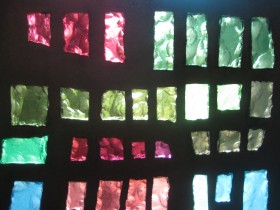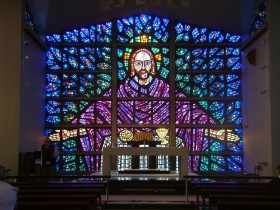Follow the brown signs



Can everyone just be a bit quiet?
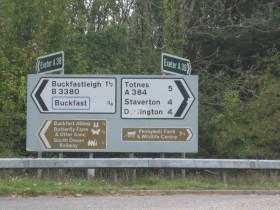 On my way back from Plymouth (once again with my foot to floor just about hitting 60 trying to make it back for my evening shift) I saw this brown sign for Buckfast Abbey on the edge of Dartmoor off the A38. Chris had told me I’d pass the abbey on the way home and when he mentioned it was real life functioning monastery I was extremely excited. I don’t think I’ve ever visited a monastery with actual monks in it outside Asia and I’ve always been interested in the quiet, spiritual and earthy monastic way of living. I read The Name of The Rose by Umberto Eco (undoubtedly one of the most talented and genius writers of all time) a few years ago and I still think about it. It tells the tale of 2 travelling Benedictine monks visiting an abbey in Northern Italy in 1327 and their struggle to solve a mysterious string of monk deaths that occur during their stay. Its absolutely amazing and uses semiotics (the study of signs, symbols and patterns), biblical analysis, medieval studies and literary theory. So afterwards I read up on the rise and fall of the Benedictine Order and the history of monasticism in general, and it won’t surprise you dear reader to hear I found it absolutely fascinating. Here comes the history bit…
On my way back from Plymouth (once again with my foot to floor just about hitting 60 trying to make it back for my evening shift) I saw this brown sign for Buckfast Abbey on the edge of Dartmoor off the A38. Chris had told me I’d pass the abbey on the way home and when he mentioned it was real life functioning monastery I was extremely excited. I don’t think I’ve ever visited a monastery with actual monks in it outside Asia and I’ve always been interested in the quiet, spiritual and earthy monastic way of living. I read The Name of The Rose by Umberto Eco (undoubtedly one of the most talented and genius writers of all time) a few years ago and I still think about it. It tells the tale of 2 travelling Benedictine monks visiting an abbey in Northern Italy in 1327 and their struggle to solve a mysterious string of monk deaths that occur during their stay. Its absolutely amazing and uses semiotics (the study of signs, symbols and patterns), biblical analysis, medieval studies and literary theory. So afterwards I read up on the rise and fall of the Benedictine Order and the history of monasticism in general, and it won’t surprise you dear reader to hear I found it absolutely fascinating. Here comes the history bit…
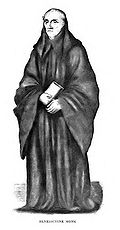 The evolution of monasticism comes, at it’s very basic root, from the desire to live in prolonged solitude. In the long term this results in a person’s release from their human “passions” (Socrates defined these as lust, anger, envy and fear) which hamper, distract and distort the effective working mind. In the 5th Century BC a man we all know as Buddah got up one day at the age of 29 and decided to leave his “normal” life behind him. He spent the next 6 years almost entirely alone sitting under a banyan tree. But Buddah wasn’t the first to do this, Hindu holy men had been doing similar things long before in search of inner peace and the experience of a deep spiritual connection with God. However, these hermits’ choices to live in solitude and engage in very individual personal pursuits paradoxically attracted much attention and inspired dedicated followers. Soon monasteries began emerging; places where like-minded individuals could live together in quiet harmony dedicating their lives to God, lead by the original hermit (who translates now to a modern day Abbot).
The evolution of monasticism comes, at it’s very basic root, from the desire to live in prolonged solitude. In the long term this results in a person’s release from their human “passions” (Socrates defined these as lust, anger, envy and fear) which hamper, distract and distort the effective working mind. In the 5th Century BC a man we all know as Buddah got up one day at the age of 29 and decided to leave his “normal” life behind him. He spent the next 6 years almost entirely alone sitting under a banyan tree. But Buddah wasn’t the first to do this, Hindu holy men had been doing similar things long before in search of inner peace and the experience of a deep spiritual connection with God. However, these hermits’ choices to live in solitude and engage in very individual personal pursuits paradoxically attracted much attention and inspired dedicated followers. Soon monasteries began emerging; places where like-minded individuals could live together in quiet harmony dedicating their lives to God, lead by the original hermit (who translates now to a modern day Abbot).
Throughout the middle ages a few monastic Orders grew significantly in popularity and hundreds of monasteries were built to house the monks who chose to live their lives by the Rule. A strong emphasis was on self-improvement and scholarly activities were a big part of daily life, as well as prayer and contemplation. During this time monks travelled around from monastery to monastery all over Europe, and indeed the world, taking months and even years to reach other abbeys, to spread their teachings and knowledge with unwavering spirit and absolute dedication to the value of God’s word. They were the early adventurers, blazing trails on donkeys inspiring learning and asking questions about the meaning of life, why we’re all here and offering advice about how to live life to truly get the most out of it. There have been massive ups and downs for the various monastic Orders during their long and interesting histories, including the near nail in the coffin for British abbeys during the Dissolution of The Monasteries, but the unfailing spirit that has stayed alive and kept a small but dedicated number of people following rules written thousands of years ago by a few influential solitary soles still remains today.
The story of Buckfast has a similarly chequered and fascinating history (which I obviously spent ages reading about on a bench before I did anything at all there). The first abbey at Buckfast was founded in 1018 (a whole THOUSAND years ago people) and continued to function as an abbey until 1539 when King Henry VIII decided the church was getting far too much royal money and a massive ransacking and demolition of gorgeous abbeys all over the country ensued. The tactic proved a quick and effective way of halting an ancient tradition and way of life for thousands of monks. Thus the abbey was abandoned and stood in ruins for 350 years until 1882, when a group of monks of the Benedictine Order who had been exiled from France bought the ruins for £4,700 and settled there. Slowly work began and incredibly, in only 30 years with virtually no money or modern machinery, just with bare hands, rudimentary tools, grit and determination the group of 6 monks restored and rebuilt the shell of this once magnificent place back to its former glory. Only one of the monks, Brother Peter, had any experience at all in building and stone masonry, but clearly the others picked up the skills needed to build an enormous and jaw-droppingly beautiful abbey quickly, because on the 25th of August1932 the abbey was consecrated to a packed out congregation. This amazing feat and absolute determination of just a few souls to restore the abbey and bring it back to its original purpose is almost unbelievable. During my research and writing of this blog I was so in awe of it all that I summed it up excitedly to my flat mate (while he sat on hold to the Apple Store, clearly grateful for the break from the monotonous music and constant lies that he’d be dealt with shortly). He looked at me sceptically when I told him that only 6 monks had built the abbey on the front of the glossy brochure I squashed in his face in just 30 years. He actually wouldn’t believe me until I showed him photographic evidence, and later I found this gem from British Pathe about the consecration of the abbey – even better…
A DREAM COMES TRUE!
Luckily the mission to rebuild the abbey was well documented by the monks through photographs and these are all around the church to show just how the space you’re walking around in came to be. Here’s just one of my many photos, which as ever do the place absolutely no justice…
The monks at Buckfast have a strong tradition of creating, and produce high quality natural products that can be both used at the abbey and sold to supplement the abbey’s income. The three things Buckfast is best known for are: a chunky and unique type of stained glass, Buckfast bees (trademarked, not joking) and Buckfast Tonic Wine. Here’s a picture of a tiny part of the huge stained glass window at the abbey up close, and underneath the piece de resistance in the chapel, gorgeous. The process involves hand cutting every single piece and setting it in a thick resin (2nd pic Stained Glass Window at Buckfast Abbey (Neil Kennedy) / CC BY-SA 2.0).
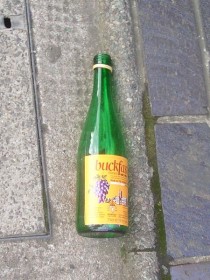 Buckfast wine was brought to the abbey with the monks who settled there in the 1880s and remained a secret recipe for some time until health and safety standards on food produced for resale meant all the ingredients had to be printed on the label. It was produced as a “tonic” which was reputed to have health benefits. However, the abbey lost the right to distribute their wine in the ’90s and now an external company does it. In a strong and rather worrying juxtaposition the main bulk of sales goes straight up to Scotland for rapid consumption by Scottish youths. The high alcohol content drink has become strongly associated with the “ned” (yob) culture in Scotland with more and more pressure being put on the government to ban the sale of Buckfast Wine completely in certain areas. It was mentioned no less than 5,638 times in official crime reports over 3 years, that equates to 3 crimes per day being associated with it. The monks and distributors deny that their drink is the problem and that the responsibility for tackling anti-social behaviour and crime figures does not lie with them, it is after all up to the individual to “drink responsibly”. Of course alcohol in general is the problem here and not specifically a certain brand but still, the Buckfast Tonic Wine debate certainly must pose some interesting ethical questions for the monks of Buckfast.
Buckfast wine was brought to the abbey with the monks who settled there in the 1880s and remained a secret recipe for some time until health and safety standards on food produced for resale meant all the ingredients had to be printed on the label. It was produced as a “tonic” which was reputed to have health benefits. However, the abbey lost the right to distribute their wine in the ’90s and now an external company does it. In a strong and rather worrying juxtaposition the main bulk of sales goes straight up to Scotland for rapid consumption by Scottish youths. The high alcohol content drink has become strongly associated with the “ned” (yob) culture in Scotland with more and more pressure being put on the government to ban the sale of Buckfast Wine completely in certain areas. It was mentioned no less than 5,638 times in official crime reports over 3 years, that equates to 3 crimes per day being associated with it. The monks and distributors deny that their drink is the problem and that the responsibility for tackling anti-social behaviour and crime figures does not lie with them, it is after all up to the individual to “drink responsibly”. Of course alcohol in general is the problem here and not specifically a certain brand but still, the Buckfast Tonic Wine debate certainly must pose some interesting ethical questions for the monks of Buckfast.
The last, less controversial product comes from Buckfast bees. These are a trademarked species of bee that were painstakingly bred by one of the monks throughout his life at the abbey. Brother Adam travelled far and wide to select the right bees to breed together and try to find the ultimate disease resistant, gentle, good honey producing bee. There are even “bee boles” still in the ancient walls at the abbey (bee boles were early bee hives where wicker baskets would be set into a hole and the bees could be kept and the honey harvested. I wrote about bee boles in my “marriages and death” blog here too). Brother Adam finally settled on his correct bee and now Buckfast honey is one of the most popular of the monks’ produce (I sadly couldn’t buy any though because, quel surprise, I only had just about enough money to cover my petrol home, annoying).
Buckfast was an unbelievably interesting visit along my Brown Sign Way and it really got me thinking, even long after I’d left the abbey. There’s something just really inspiring about people who choose a different life to the “normal” life and when they’re living in peace and harmony together, enjoying the pleasures of engaging in natural pursuits and dedicating their lives to something they feel so passionately about then of course I am going to be a fan. I might just be closing this computer down right now and booking myself in for a retreat actually…








